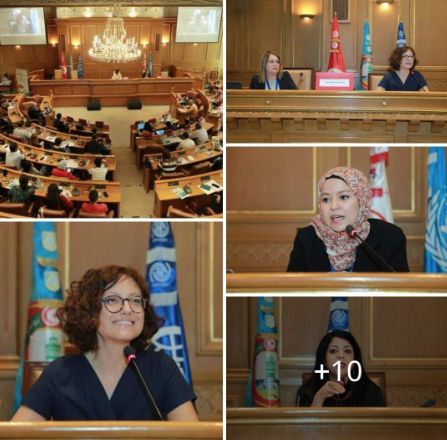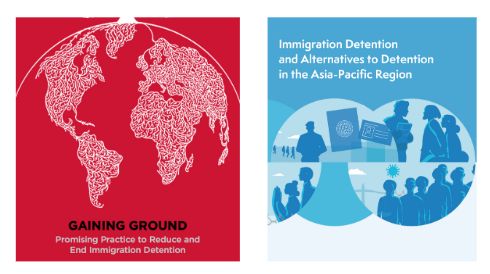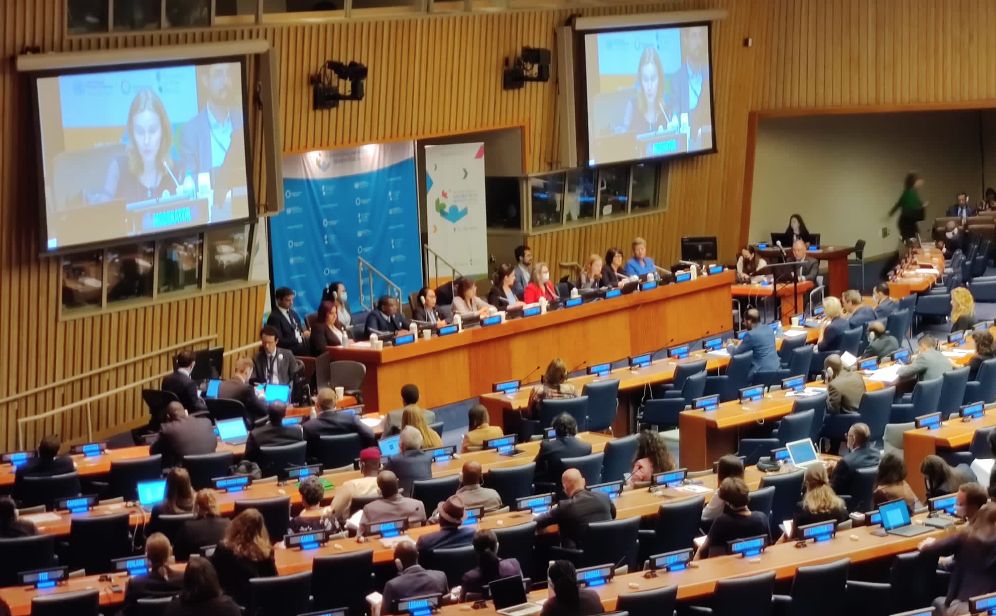10 Years of IDC’s Work to End Child Immigration Detention
Over ten years ago in 2012, International Detention Coalition (IDC) launched the Global Campaign to End Child Immigration Detention (the Global Campaign) at the 19th Session of the United Nations Human Rights Council in Geneva, Switzerland, supported by the Office of the High Commissioner for Human Rights (OHCHR). Later that year, the Committee on the Convention of the Rights of the Child issued key recommendations on the rights of children on the move, and highlighted IDC’s proposed model for a move to community-based alternatives for children.
With the simultaneous release of Captured Childhood, a report based on 70 interviews of children with lived experience of immigration detention across 11 countries, IDC set in motion a global movement grounded in the vision of a world that cherishes the humanity and dignity of children. Specifically, IDC campaigned to persuade the international community and governments that the immigration detention of children and their families is always a child rights violation and is never in the best interests of the child. IDC offered evidence of positive actions that States could take instead of depriving children of their freedom, and put forward practical and current evidence of a new perspective of rights-based alternatives where children and their families could live in non-custodial community-based settings while their immigration cases were being resolved.

The Global Campaign joined opinions across diverse sectors in different parts of the world advocating for an end to immigration detention of children and families, with the message that immigration detention is never an appropriate place for a child and is never in the best interest of the child. The Global Campaign amplified the voices of children in detention through The Invisible Picture Show and showed the negative impact of even short periods of immigration detention on their mental health and development. The campaign called on States to step up to their international obligations, and ensure that all refugee and migrant children:
- Be treated first and foremost as children
- Be free
- Be looked after according to their best interests
- Live in freedom in the community with their parents or primary care-givers
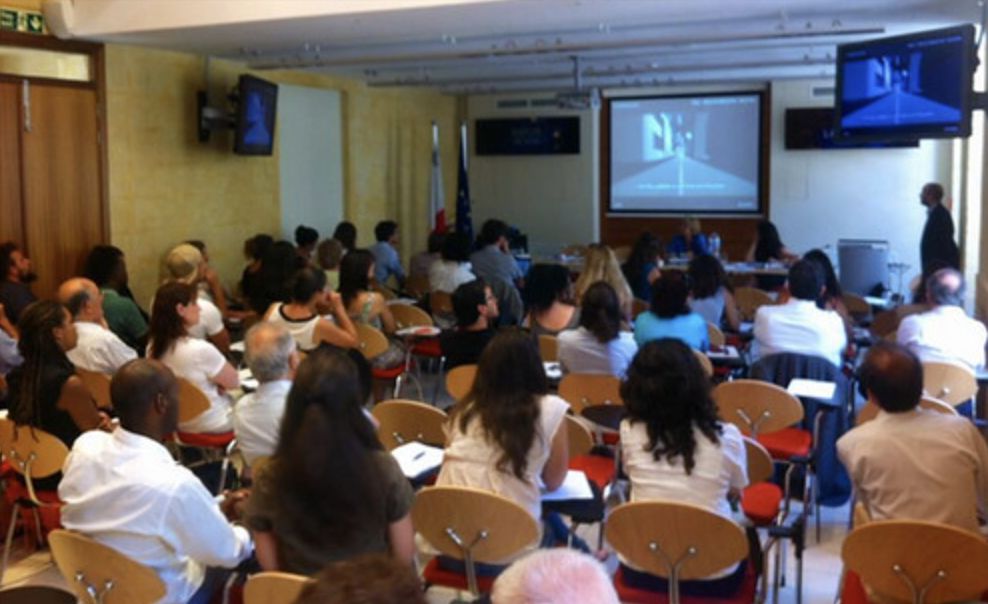
As the Global Campaign expanded, it became a platform for national campaigns and advocacy strategies calling for an end to the immigration of children around the world, most notably in Australia, Greece, Malaysia, Mexico, South Africa and Tanzania, as seen in the Global Campaign’s history.
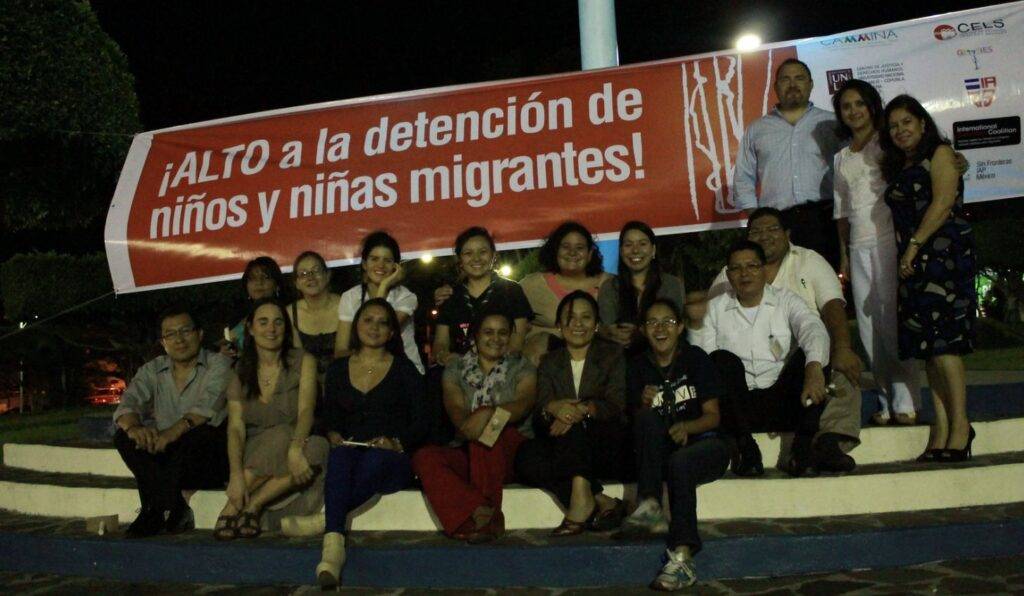
The Campaign also brought to light the issues of regional protection of children, for example family separation with detention and deportation procedures in the United States and the mass deportations of children and families to the Central American countries of Guatemala, Honduras and El Salvador.
IDC mobilised for States to adopt child-friendly, rights-based, humane, non-custodial and community-based alternatives to detention (ATD), as seen in this advocacy video developed in 2015 by IDC and partners A Tale of Two Children.
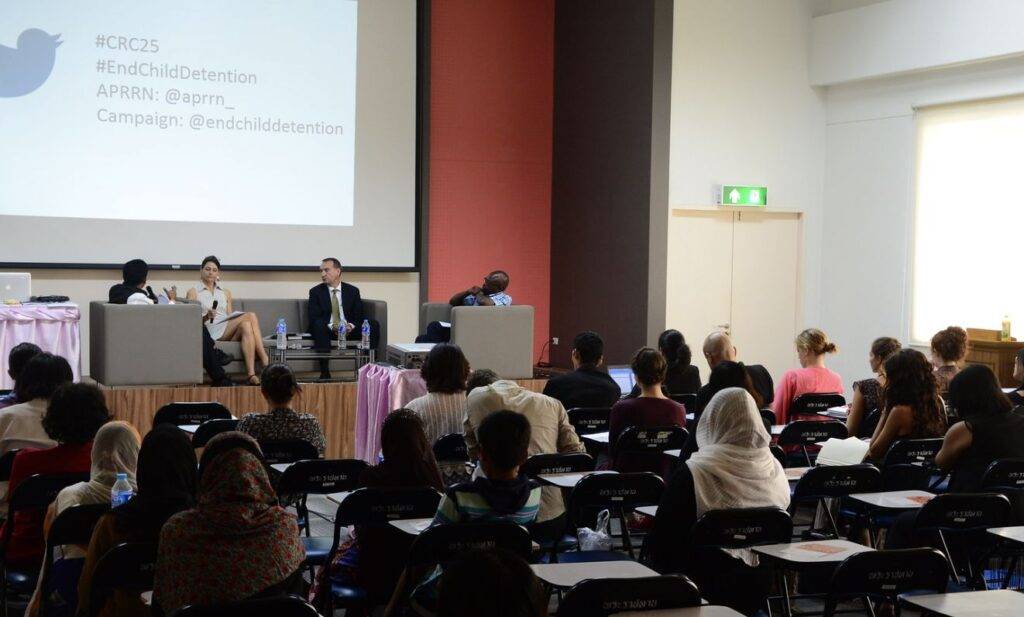
Following this, IDC also launched the NextGen Index in 2018, which served as a comparative tool to rank States on their progress in ending child immigration detention. The Index used a standard scoring framework to assess strengths, weaknesses, and key factors to ensure national migration management systems are sensitive to the needs of children and, importantly, avoid child detention.
The Inter-Agency Working Group (IAWG) to End Child Immigration Detention, an international alliance of civil society organisations and UN entities was key to convening global advocacy efforts from 2012 until 2018, with a critical turning point in the obligation of States being the adoption of the New York Declaration for Refugees and Migrants by the UN General Assembly in 2016. The subsequent negotiation process of the Global Compact for Migration and its adoption in 2018 represented a significant win by collective global advocacy efforts, in that it includes a clear commitment by States to work to end child detention by focusing on ensuring availability and accessibility of alternatives in non-custodial contexts.
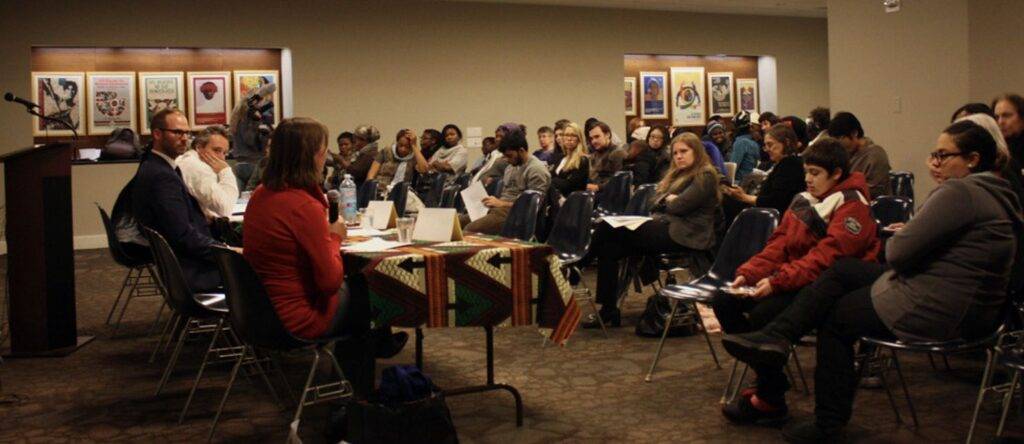
The 2019 release of the UN Global Study on Children Deprived of Liberty, to which IDC and its Global Campaign were key contributors, further added to the growing body of expert evidence on the harms of immigration detention on children and families, the extent of the practice and the solution-oriented approach based on alternatives.
Since 2018, the implementation of the Global Compact for Migration has provided a platform to concretely discuss and share national practice, legal and policy frameworks in global spaces. IDC pioneered efforts in this direction by leading regional and global discussions to develop a cross-regional peer learning platform on ending child immigration detention. This initiative led to the inclusion of peer learning as part of the UN Network on Migration Work Plan and the creation of the UN Network on Migration Working Group on Alternatives to Detention in 2019.
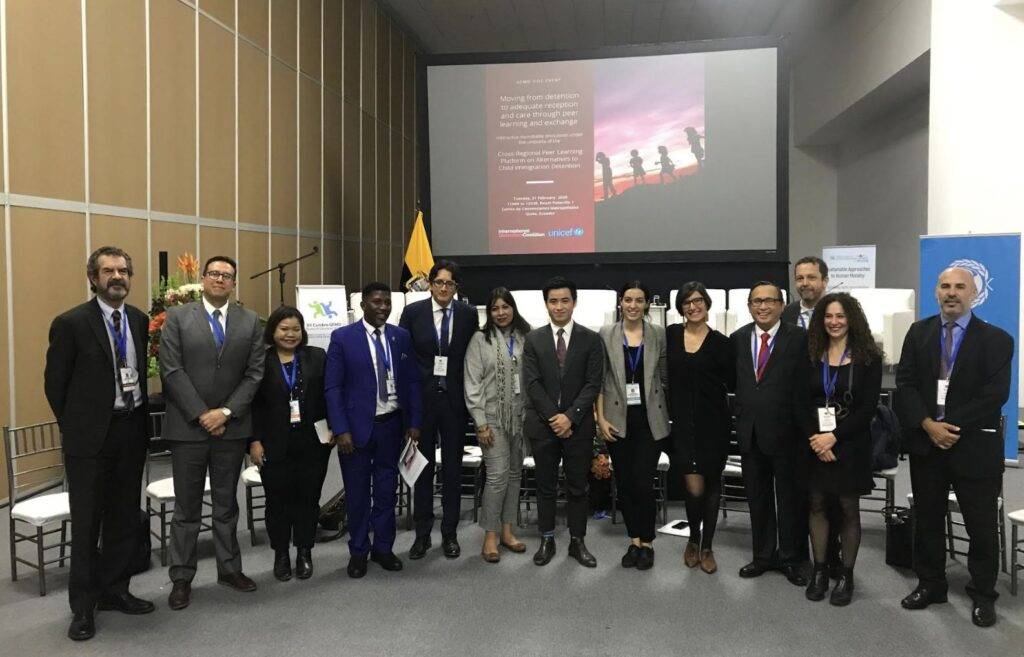
Since 2019, IDC co-leads the UN Network on Migration Working Group on Alternatives to Detention (ATD) alongside UNICEF and UNHCR, which prioritised supporting States in their work to end child immigration detention through global and cross-regional peer learning exchanges, organised in collaboration with the governments of Thailand, Colombia, Nigeria, Ghana, and Portugal. Recently the Working Group produced a global snapshot on Ending Child Immigration Detention, which highlights efforts in Mexico and Zambia, as well as an accompanying video. The Working Group is planning, together with key champion States, another peer learning exchange on ending child immigration detention in 2023.
We saw further international progress into 2021 with General Comment 5 to the International Convention on the Protection of the Rights of All Migrant Workers and Members of their Families, which called for child immigration detention to be fully eradicated globally. Child immigration detention was also a centrepiece of detention-related discussions at 2022's International Migration Review Forum (IMRF), with some States making pledges to end the practice entirely.
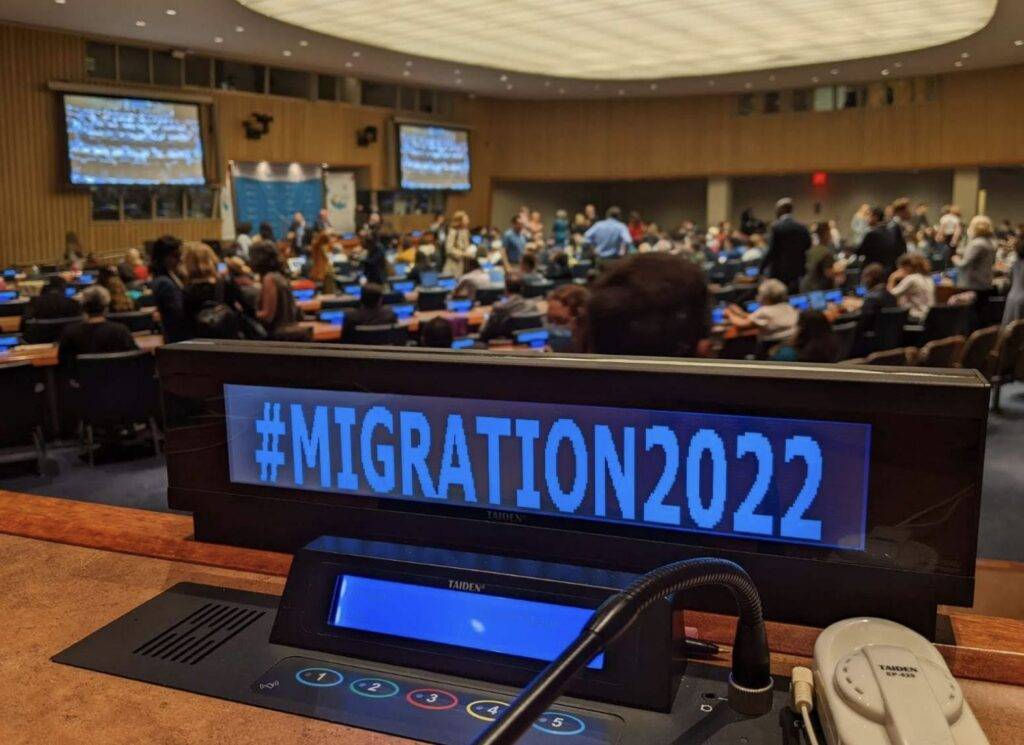
Where Change Happens
While the influence of global standards and political frameworks is a critical point of intervention for IDC, the core of our work exists at local and national levels, which is where change and impact is directly felt by communities at risk of immigration detention.
Following over a decade of coordinating multi-level advocacy, collaboration between civil society organisations, international partners, federal and local government authorities, and communities in Mexico, IDC was proud to be part of an historic political moment in 2020 when the Mexican Congress declared that immigration detention is no place for children.
This 2020 legislative reform that now legally prohibits the detention of children for immigration reasons came on the heels of a pioneering collaboration in joint advocacy by migrant and child rights groups in Mexico. This collaborative IDC work involved key partnerships with UNICEF and UNHCR, the Global Campaign, hearings before the Inter-American Commission on Human Rights, as well as clear recommendations to Mexico from the IACHR and the United Nations Committee on the Rights of the Child.
New legislation in 2014 established a national protection system for all children, along with regulations that specifically prohibited their confinement in immigration detention centres. This opened up opportunities for deeper IDC engagement with immigration authorities, providing technical advice for the development and implementation of the successful first ATD pilot for unaccompanied children. The pilot was developed and implemented in collaboration with SOS Children's Villages (Aldeas Infantiles) and Covenant House (Casa Alianza), two organisations with strong community models and long-term experience working with children in Mexico. ATD initiatives demonstrated how children and families can be supported to live in the community as they participate in their ongoing migration or asylum process.

In the challenge to contribute towards effective implementation of the legal prohibition on child detention, IDC continues to prioritise engagement with the National Commission for the Protection of Migrant Children through capacity building and technical advice at federal, state and local levels. As a result of these efforts, we have seen the adoption of a National Protocol for the Protection of Migrant Children and we are currently working with state committees to develop and adopt local protocols that will serve to improve protection gaps and coordination among authorities at borders and along migration routes.
IDC believes it is important to continue to work on the ground, as close as possible to children and families with lived experience, local authorities and local civil society organisations, especially public and private shelters to strengthen community-based reception and care models. We also continue engagement with the Mexican legislature including training and harmonisation of the legal framework.
IDC Americas Regional Coordinator Gisele Bonnici states of these long-term efforts:
“Working side by side with our dedicated partners in Mexico, IDC continues to promote and support practical implementation of effective and appropriate community-based reception and care options for migrant and refugee children. Our goal is that no child, whether travelling accompanied or unaccompanied, be detained for any period of time in any type of space for immigration reasons.”
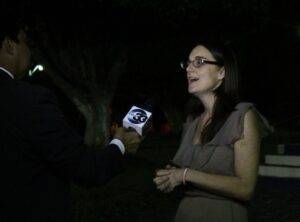
Similarly, in 2019, representatives of 7 Thai Government agencies signed the Memorandum of Understanding on the Determination of Measures and Approaches Alternatives to Detention of Children in Immigration Detention Centres (ATD-MOU), as well as Standard Operating Procedures (SOPs) to implement the MOU-ATD starting in September 2020. The MOU-ATD was a concrete outcome of a pledge made by Prime Minister Prayut Chan-o-cha during the 2016 Leaders’ Summit on Refugees at the United Nations in New York. At the summit, he publicly pledged to end the immigration detention of refugee and asylum seeking children in Thailand.
Following this huge political commitment, IDC has worked with local partners, such as HOST International to collate and strengthen the evidence-base that can be used to increase practical understanding of community-based, rights-based, and gender-responsive ATD to better protect children and their families in the context of migration; including, a Global Promising Practices on ATD which contextualised our design to the Thai context, a Community-based Case Management Programme Evaluation, as well as an accompanying Practices Guidelines on Community-based ATD in Thailand. Along with the Thai government Department of Children and Youth – Ministry of Social Development and Human Security (DCY) and UNICEF Thailand, IDC developed a government Monitoring, Evaluation, and Learning (MEL) framework in line with key international standards to track progress on the MOU-ATD implementation. The evaluation led by DCY aims to take place in 2023 as a collaborative effort of key stakeholders in Thailand.

For several years now, IDC has seen our members and partners engaged in advocacy and service provision for children impacted by immigration detention. With IDC’s support, members in Thailand and Malaysia define strategies to end child immigration detention in their countries. These strategies have prioritised and coordinated efforts towards the ultimate goal of ending the immigration detention of children and their families.
IDC Southeast Asia Programme Manager Mic Chawaratt states of IDC’s efforts in Thailand:
“Political will, commitment to the best interest of the child, and multi-stakeholder collaboration have been the key drivers of advocacy efforts among Thai civil society, government partners, UN agencies, the diplomat community, academics, and people whose lives are impacted by immigration detention. I believe that one day immigration detention will no longer exist in my country, and people who migrate here will live with rights and dignity – which is IDC’s vision for the world.”
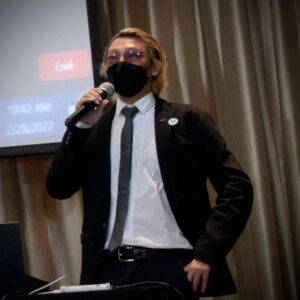
Additionally in the Asia Pacific region, the Ministry of Home Affairs in Malaysia officially launched an ATD pilot programme in February 2022 for unaccompanied and separated children following approval of the pilot by the Malaysian cabinet in 2021. This was a key milestone for IDC following a decade of ongoing advocacy that centred around an incremental and collaborative strategy alongside our members, the human rights commission (SUHAKAM) and UN agencies. The national campaign in Malaysia was originally spurred by the Global Campaign, and provided leverage and a space to engage a broad number of groups around the issue, while previously the discussion on this issue was severely limited. Now, the planning, development and implementation of the pilot is being supported by IDC partners SUKA Society and Yayasan Chow Kit.
Following this development, IDC continues to coordinate the End Child Detention Network Malaysia (ECDN), and brings members together to discuss strategy and collective advocacy efforts. IDC has also started a public engagement programme in Malaysia, including new initiatives focused on developing public and media engagement strategies on refugee and migrant rights.
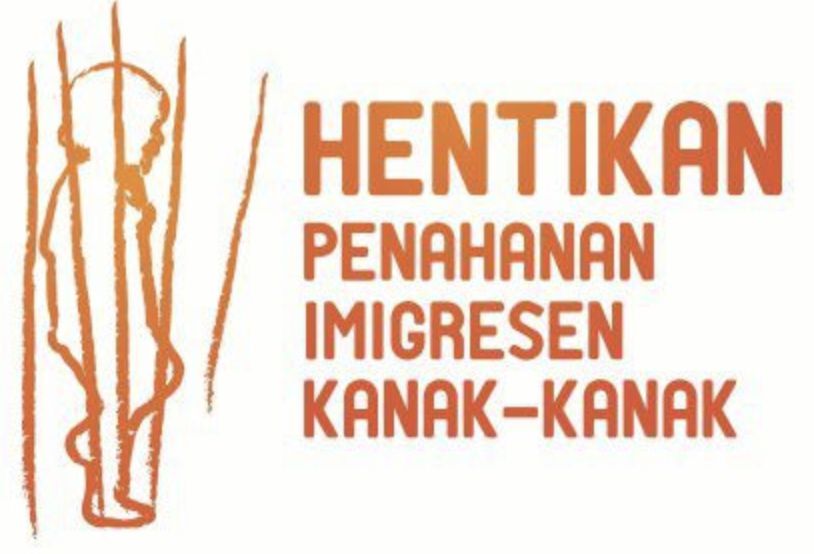
In the Middle East and North Africa (MENA) this year, and in partnership with UNICEF, IDC organised a series of online ATD trainings focused on screening, assessment, referral mechanisms of children, as well as case management and community placement options for children. IDC believes that these critical elements serve as a framework for identifying and developing rights-based ATD. This training series aims to strengthen the capacity of civil society organisations, as well as bring together a network of actors working in the field of ending child immigration detention across the region. The latest training in October 2022 was attended by 50 participants working on issues related to refugee and migrant children from more than 10 countries in the MENA region.
IDC has also carried out a mapping research with UNICEF on the current legislations, policies and practices with regards to child immigration detention in the MENA region. This led to the production of two policy briefs targeting governments; which aim to support sharing among governments in the MENA region, and to strengthen practices in line with the Convention on the Rights of the Child and the Global Compact for Migration (GCM). The mapping analysed trends and identified promising protection and care practices for refugee and migrant children with a focus on child-sensitive alternatives to custody across 9 countries in the MENA region: Djibouti, Egypt, Jordan, Lebanon, Libya, Morocco, Tunisia, Saudi Arabia, and Sudan.
In November 2022, IDC co-organised with UNICEF a regional workshop for 8 governments in the MENA region, to present and share promising protection and care arrangement practices for children on the move, from across the region and beyond, facilitating discussions and exchanges on common challenges, strengths, and proposed ways forward for their countries and across borders. The workshop highlighted key aspects from the child protection continuum from identification and referral to alternative care models specifically highlighting promising practices on child protection including child sensitive alternatives to custody.
In Europe, meanwhile, efforts have been ongoing to advocate for an end to child detention. The conditions set out in EU law, alongside the requirements of the European Convention on Human Rights and the case law of the European Court of Human Rights, make it clear that depriving children of their liberty is only permissible in exceptional circumstances. Despite this, however, at least 27 countries in the region still detain children. IDC has been working with civil society organisations across Europe to train policymakers, child protection experts, judges and lawyers on the legal requirements of states when it comes to ensuring alternative care arrangements for children. This has included working with the International Commission of Jurists to support the roll-out of a set of training materials on ATD for migrant children. In addition, the Belgian member of the European ATD Network - which IDC coordinates - has been implementing an ATD for families with children since 2020, working to ensure that children can live in the community while they and their parents work to resolve their migration status.

As with any major policy chance, progress often feels slow and can even appear to be moving backwards at times. The provisions for reception and border procedures set out in the new EU Pact on Migration and Asylum, for instance, are likely to result in a dramatic deterioration of the rights of people on the move, including children. Yet there remain signs of hope; Germany's pledge at the 2022 IMRF to end immigration detention of children, and indications from a number of governments that they are working to integrate children on the move into mainstream protection systems, show that there is still space to move forward with this agenda.
Lived Experience at the Centre
In 2012, the UN Committee on the Rights of Child declared that immigration detention is a violation of a child’s rights. This declaration represented a clarity of language that began a shift in international law, and the shift was made following a performance by five young advocates who IDC partnered with to share their experiences of detention, as well as their proposed solutions, at the UN. They curated a theatre piece called Hear Our Voices, and powerfully stood before global policy makers and academic experts to stake their claim on this issue. Together, they moved the dial on child immigration detention worldwide.
IDC continues to believe that people with lived experience of detention need to be involved in shaping the policies that directly impact their own lives and communities. IDC recently co-organised the Children and Youth Affected by Migration-Led Advocacy Workshop, which involved conducting youth engagement training for 43 different local partners, as well as leadership and advocacy training for 175 migrant and refugee children and youth in Thailand. The youth leaders were then invited to share a statement directly with policy-makers in April 2022 at a forum attended by Thailand’s Representative to ASEAN Commission on the Promotion and Protection of the Rights of Women and Children (ACWC), representatives from the Thai government, as well as international organisations and NGOs.
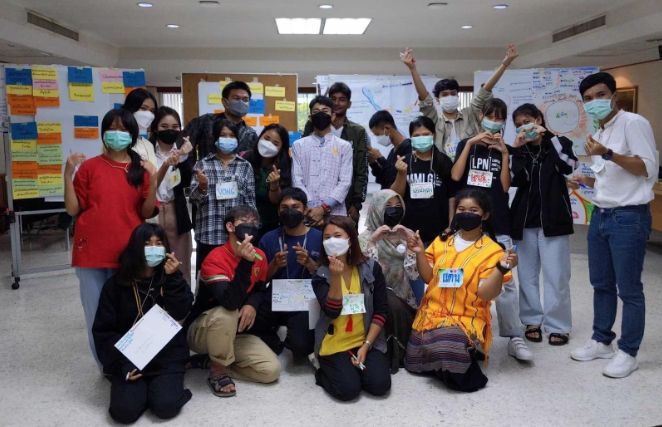
Further in Malaysia, IDC works with Akar Umbi, a local NGO, to conduct a leadership programme called the Azalea Initiative with a group of young refugee women in Kuala Lumpur. The programme’s goal is to support their empowerment, and build their capacities as changemakers within their communities.
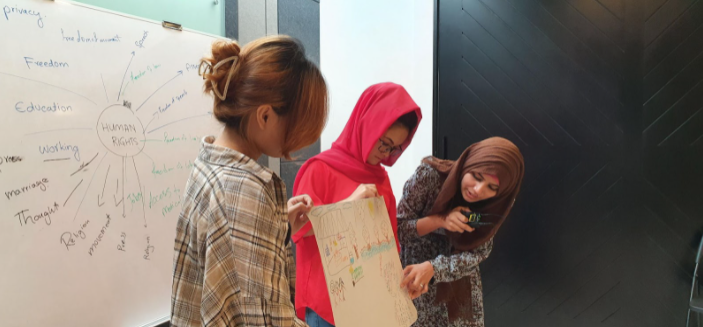
In Mexico, IDC and its partner SOS Children’s Villages in Comitán, Chiapas have engaged young people from migrant communities in leadership training and activities, piloting methodology adapted from IDC’s Community Leadership Curriculum. IDC also worked with partners to support migrant children to create video documentaries of their own experiences and hopes for the future.
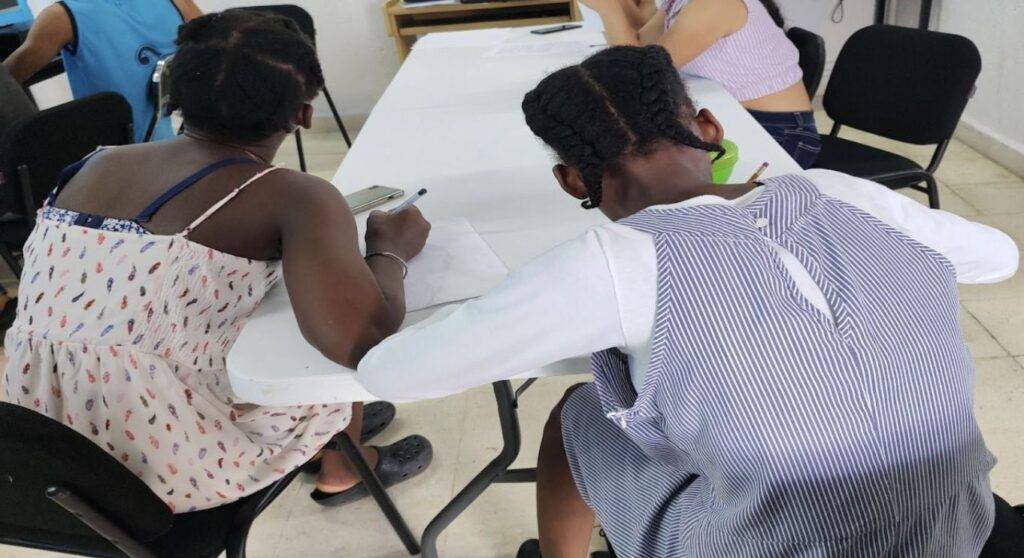
Grounded, community-based efforts like this, alongside coordinated advocacy strategies to amplify impact, have been the heart of IDC’s work to end child immigration detention worldwide. While we have taken the lead on global events and international outcomes on child detention, we have also worked side by side with regional partners and national coalitions to develop tailored and transformative strategies that make a real impact on the ground. This year, IDC re-commits to our ten year, long-term effort to end the immigration detention of children all over the world, in line with our broad vision of ending immigration detention for all.
Written by Gisele Bonnici, IDC Americas Regional Coordinator and Mia-lia Boua Kiernan, IDC Communications and Engagement Coordinator
An Interview with IDC Member: Terre D’asile Tunisia
IDC aims to highlight the critical and important work to end immigration detention being implemented by civil society actors in the MENA region. IDC’s MENA Programme recently interviewed Sherifa Riahi, Country Director of Terre D’asile Tunisia to share insights on these efforts in the region.
Terre D’asile Tunisia was founded in 2012 in Tunisia as a section of Terre d’Asile France. Its mission is to enhance social cohesion and protection, and promote the rights of migrants, refugees, people seeking asylum, unaccompanied minors, and human trafficking survivors living in Tunisia.
Challenges facing migrants and refugees in Tunisia
Sherifa explained that the arbitrary arrest and detention of refugees continues from time to time. Further, there are discriminatory practices based on skin color, ethnicity, social class and language. In addition to arbitrary detention, the lack of a case management system makes the situation more challenging. There is no proper identification of trafficked persons to ensure appropriate care, or proper age assessment of children to ensure referral to child protection authorities.
Interpretation services are severely limited, which means that migrants are not provided with information about their rights, detention, or complex migration processes in languages that they understand. Additionally, Tunisia does not finance deportation processes, and so those facing deportation must expense their own return.
The work of Terre D’Asile and other civil society organisations
Tunisian civil society works to support migrants and refugees facing these concerning conditions and situations. Terre D’asile Tunisia plays an important role in implementing different support mechanisms throughout people’s experience in Tunisia. Terre D’asile Tunisia provides legal support to people in detention, including legal consultations, reporting mistreatment to public institutions, and particularly supports the detention cases of trafficking survivors and children. Terre D’asile Tunisia also provides social assistance to those who are detained, through the delivery of essential items, such as hygiene kits.

Key highlights in the past period
- Terre d’Asile Tunisia is part of a Working Group on Arbitrary Detention, alongside Organisation Mondiale Contre la Torture (OMCT), Avocats Sans Frontieres (ASF) and Forum Tunisien pour les Droits Economiques et Sociaux (FTDES). This Working Group has recently been able to secure the release of more than 25 people from detention in Tunisia.
- Terre d'asile Tunisia is currently establishing a new day care center for migrant and Tunisian children in vulnerable situations which will be operating in January 2023. The organisation leads this project, and uses a case management approach to provide tailored support that responds directly to children’s needs. An initial reception and needs assessment is completed, followed by a response plan addressing the most urgent needs, as well as long-term support for the development of their lives and futures.
MENA Regional Programme Updates
IDC’s MENA Regional Coordinator Amera Markous recently presented at the the 7th edition of the Summer School on Migration in Tunisia, organised by IOM Tunisia in partnership with the National Institute of Labor and Social Studies (INTES) in September 2022. The forum’s theme was “Children and Migration,” and IDC provided a comprehensive introduction to alternative care options for migrant children, and presented several examples of alternatives to detention (ATD) from the Middle East and North Africa (MENA) region, as well as from other regions. The video recording of IDC’s intervention is available here in Arabic.

The presentation focused on the impacts of detention on children, such as the severe harm to children’s physical and mental health, and overall wellbeing. IDC also reminded the audience that detention is never in the best interest of the child, as per the Convention on the Rights of the Child (CRC). IDC MENA Regional Coordinator explained the positive impacts of ATD, based on evidence and research carried out by IDC across different parts of the world. Additionally, Amera highlighted promising practices towards ending child immigration detention, which reflect the role of the governments, legislators, civil society, UN agencies and local communities including leaders with lived experience in creating whole-of-society and whole-of-government implementation of ATD that can protect and uphold the rights of migrant and refugee children. Such examples are featured in IDC’s recent report: Gaining Ground: Promising Practice to Reduce & End Immigration Detention.
Capacity Building for Civil Society in MENA
In partnership with UNICEF, IDC organised an online ATD training on 20 October 2022. The training focused on screening, assessment, referral mechanisms of children, as well as case management and community placement options for children. IDC believes that these critical elements serve as a framework for identifying and developing rights-based ATD. This training aims to strengthen the capacity of civil society organisations, as well as bring together a network of actors working in the field of ending child immigration detention across the region.
Our training was attended by 50 participants working on issues related to refugee and migrant children from more than 10 countries in the MENA region. Continue to follow us for future updates!
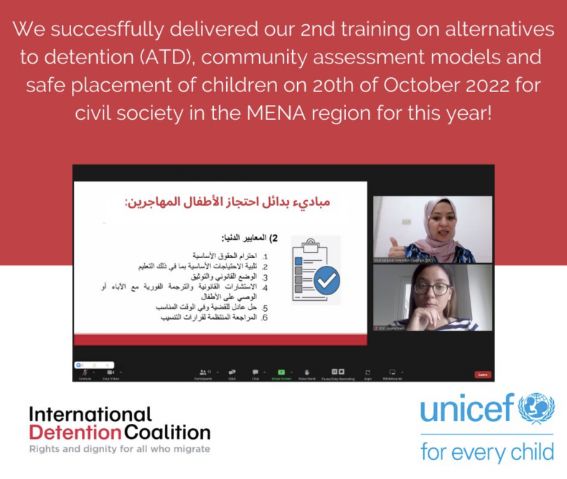
An Interview with IDC Member: Terre D’asile Tunisia
IDC aims to highlight the critical and important work to end immigration detention being implemented by civil society actors in the MENA region. IDC’s MENA Programme recently interviewed Sherifa Riahi, Country Director of Terre D’asile Tunisia to share insights on these efforts in the region.
Terre D’asile Tunisia was founded in 2012 in Tunisia as a section of Terre d’Asile France. Its mission is to enhance social cohesion and protection, and promote the rights of migrants, refugees, people seeking asylum, unaccompanied minors, and human trafficking survivors living in Tunisia.
Challenges facing migrants and refugees in Tunisia
Sherifa explained that the arbitrary arrest and detention of refugees continues from time to time. Further, there are discriminatory practices based on skin color, ethnicity, social class and language. In addition to arbitrary detention, the lack of a case management system makes the situation more challenging. There is no proper identification of trafficked persons to ensure appropriate care, or proper age assessment of children to ensure referral to child protection authorities.
Interpretation services are severely limited, which means that migrants are not provided with information about their rights, detention, or complex migration processes in languages that they understand. Additionally, Tunisia does not finance deportation processes, and so those facing deportation must expense their own return.
The work of Terre D’Asile and other civil society organisations
Tunisian civil society works to support migrants and refugees facing these concerning conditions and situations. Terre D’asile Tunisia plays an important role in implementing different support mechanisms throughout people’s experience in Tunisia. Terre D’asile Tunisia provides legal support to people in detention, including legal consultations, reporting mistreatment to public institutions, and particularly supports the detention cases of trafficking survivors and children. Terre D’asile Tunisia also provides social assistance to those who are detained, through the delivery of essential items, such as hygiene kits.

Key highlights in the past period
- Terre d'Asile Tunisia is part of a Working Group on Arbitrary Detention, alongside Organisation Mondiale Contre la Torture (OMCT), Avocats Sans Frontieres (ASF) and Forum Tunisien pour les Droits Economiques et Sociaux (FTDES). This Working Group has recently been able to secure the release of more than 25 people from detention in Tunisia.
- Terre d'asile Tunisia is currently establishing a new day care center for migrant and Tunisian children in vulnerable situations which will be operating in January 2023. The organisation leads this project, and uses a case management approach to provide tailored support that responds directly to children’s needs. An initial reception and needs assessment is completed, followed by a response plan addressing the most urgent needs, as well as long-term support for the development of their lives and futures.
Socio-economic Crises, Deportations & Deaths at the Eastern Mediterranean Route
The current economic crisis in Lebanon - alongside an ongoing political and health crisis - is driving hundreds of people to risk crossing the Mediterranean Sea in order to seek safety in Europe, though multiple sources insist that estimates could be in thousands. UNHCR states that the number of people who left Lebanon by sea nearly doubled between 2020 and 2021, and “the figure rose again by more than 70% in 2022….fuelled by Lebanon’s financial collapse as poverty rates have soared among the population of 6.5 million.” Such movements have also been driven by growing discrimination and resentment towards refugee communities in Lebanon and Turkey. In September, 94 people, including 10 children, drowned off the coast of Syria when a boat carrying 150 people departed Lebanon. In another case, a boat carrying 250 people departed Lebanon for Italy, and was stranded at sea for a week without food or water until being rescued by an NGO ship. On another stranded vessel, a four year old girl from Syria, Loujin, died of thirst while waiting to be rescued in September.
As people are struggling to survive these journeys to safety, Lebanon announced a plan to return 15,000 Syrian refugees every month to Syria, and Turkey is proposing to deport 1 million people to Northern Syria through daily deportations. However, voluntary returns from Lebanon are not a new phenomenon and they have commenced even before now, with various sources stating that upward of 21,000 Syrians have been returned to Syria already before the process was halted in 2020 due to COVID-19 – although the government insists that these are voluntary returns, however, there are many concerns on this.
UNHCR reports that at least 71,771 Syrian refugees have returned voluntarily from Lebanon since 2016 up until August 2022, some through government-organised trips and some on their own. Though Lebanon has begun with the Syrians who wish to return voluntarily, there is no reassurance that forced returns will not be taking place. As per the country’s Minister of the displaced, returns will continue beyond those who wish to return voluntarily, amid insistence that Syria is now safe, as the Syrian government is now welcoming Syrian refugees back to the country. However, refugees, as well as human rights groups such as Human Rights Watch, Amnesty International and other UN Agencies such as UNHCR, are concerned about the conditions of these returns. Reports by human rights organizations have cited cases of returning refugees disappearing and getting detained and tortured. Even more alarming, is the fact that the Lebanese government has excluded UNHCR from this process. Therefore, amid these realities, boats from Lebanon continue to leave the coast headed towards Europe in order to search for safety and seek protection.
At IDC, we believe that forced reparations deny freedom and asylum to people who may face persecution upon their return, and also further exacerbate the risk of immigration detention for those seeking safety and peace. IDC supports our allies working to secure safe and legal routes for people to migrate, which end the tragic loss of life occurring in the Mediterranean Sea.
This section was developed in collaboration with Dr. Jasmin Lilian Diab, Director of the Institute for Migration Studies and Assistant Professor of Migration Studies, Lebanese American University
Border Controls & Externalisation of the Asylum System
In addition to the critical situation inside detention centres in Libya, including ongoing human rights violations, the interception and forced return of people who are trying to cross the Mediterranean Sea to Europe is frequently reported (read our previous newsletter for more details). According to IOM’s Libya Maritime update, as of September 2022, a total of 16,506 migrants have been arrested and returned back to Libyan shores to date this year, 546 of whom were minors.
There are fears rising amongst activists that Italy will apply stricter border controls, deny people the right to seek asylum, and may plan reforms to offshore the entire asylum process to third countries. Further, a report indicates that this offshore approach might include strengthening the 2017 Italy-Libya agreement, and exploring similar agreements with other North African countries. In IDC’s experience, agreements that forcibly intercept and return people on the move, as well as offshore processing arrangements, can lead to further erosion of rights and increased risk of immigration detention for many.
IDC asks European States to adhere to their obligations under international law, and ensure that no more lives are lost at sea and that people’s liberty and rights are upheld as they seek safety and protection in Europe.
Written by Asma Nairi IDC MENA Programme Officer & Amera Markous IDC MENA Regional Coordinator
Strengthening Capacity to Protect & Promote the Development of Migrant Children in the Americas
As the movement of people from one territory to another becomes increasingly more frequent, the ways in which this happens has transformed. In the recent past, groups were generally small and were transported as inconspicuously as possible. Most of the group would comprise of men, and economic-labor motivations lay behind most migration.
Current migration dynamics are more diverse: expulsion factors have increased and intensified; groups gather in caravans and travel on main highways to border points; traditionally male migration has gradually decreased with an increase of migrant women; and there has been an alarming increase in the number of children crossing borders, either accompanied, unaccompanied, or separated from their parents or legal guardians.
Such a context demands that the State, and the various actors that comprise it, develop mechanisms for the specific attention and protection of all those immersed in voluntary or forced processes of migration. Special emphasis needs to be placed on the most vulnerable, such as children, founded on the “best interest” principles of this population.
According to the Committee for the Rights of Children,[1] the best interest of the child is a right, a principle, and rule of procedure. It demands the adoption of a rights-based approach, in which all parties seek to guarantee the physical, psychological, moral, and spiritual integrity of children and to promote their human dignity, encompassing in the term “children,” both an individual and general or group character. “Best interest” of the child is thus understood as both a collective and an individual right.
The Committee has also referred to how the best interest of the child should be applied, arguing that pre-evaluations of legislative provisions, public policies, and their implementation, should be conducted in order to assess their potential effects on the rights of children, together with a post-evaluation of the consequences of their application.[2]
Considering the context of migration, as well as international doctrine and regulations, the need to support and strengthen the capacity of the various regional institutions involved in attention and protection of migrant children has been identified. This would enable the implementation of effective approaches that respond to both the humanitarian needs of this population as well as to intentional design of life projects, all founded on the best interest of the child.
In order to support the development and strengthening of the technical abilities of personnel from the above mentioned institutions, and within the framework of the 26th Regional Conference on Migration (RCM), a Diploma on Migrant Children was offered. The Diploma was designed to strengthen the technical capacity of those working in institutions that participate in processes of migrant children, in order to protect this population.
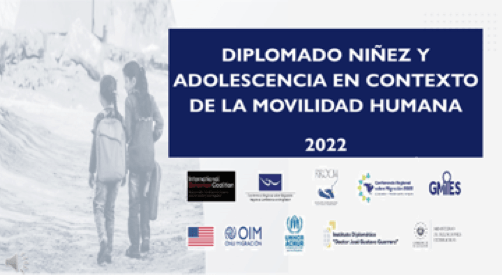
The Diploma design was based on a proposal by Grupo de Monitoreo Independiente de El Salvador (GMIES), and was reinforced by a participative and consultative process with the International Organisation for Migration, International Detention Coalition (IDC), the International Labor Organisation, and the United Nations High Commissioner for Refugees, as well as by the representation of the Pro-Tempore Presidency (PPT) and the Regional Conference on Migration. Together, this allowed for a holistic, specialised, and consensual vision of the different bodies that, from their own particular position, address one or more aspects of human migration.
The Diploma was delivered to 41 participants from public institutions and non-governmental organisations from 10 countries in the Mesoamerican region. On completion of their training, each participant received a certificate from the "Doctor José Gustavo Guerrero" Specialised Institute. This Institute provided a perfect space on their platform for the transmission and reinforcement of knowledge, including simultaneous classes for consultation and feedback; pre-recorded classes that could be watched at participants’ convenience, and forums to respond to any questions.
The Diploma was divided into three modules, progressing from a general to a specific perspective, with information on the provision of immediate attention, as well as on accompaniment and orientation for life projects that ensure a decent standard of living. A brief summary of the contents of each module is presented below:
| MODULE I. UNDERSTANDING THE REALITY OF MIGRANT CHILDREN | Exploration of the regional context and reality of migrant children, with particular emphasis on the structural causes of countries of origin that give rise to migration, as well as the characteristics of migrant children. Analysis of situations of vulnerability. Examination of risk situations, such as human trafficking, trafficking of migrants, discrimination based on indigenous identity, belonging to the LGBTTTIQA+ community, migrant detention, gender based sexual violence, among others. Provision of tools to identify vulnerabilities, with particular emphasis on interview techniques. |
| MODULE II. MIGRANT CHILD PROTECTION
| Examination of the international and regional legal framework as well as of standards for the protection of the rights of migrant children; minimum regulations for protection, asylum and statelessness, child labor. Strengthening the technical capacity of comprehensive mechanisms for the assistance and protection of migrant children: application of best interest, humanitarian action, mental health, and alternative care for unaccompanied and separated children. |
| MODULE III. IDEAL ECOSYSTEMS FOR THE DEVELOPMENT OF MIGRANT CHILDREN’S LIFE PROJECTS
| Presentation of mechanisms for reintegration in countries of origin for returned migrant children, as well as mechanisms for integration in destination countries, considering the various migration dynamics and their possible effects on migrant children Exchange of good practices for the protection and development of migrant children, and examination of state and civil society responses to the current reality. |
The Diploma ended on 13 October 2022.
[1] United Nations Organization, Committee for the Rights of Children, General observation Nº 14 (2013) on the rights of the child to have their best interests taken as a primary consideration (article 3, paragraph 1). Approved by the Committee in its 62nd session, held from January 14 to February 1, 2013.
[2] Op. Cit.
Written by Pamela Anthuanee Franco, Grupo de Monitoreo Independiente de El Salvador (GMIES)
Exchange of Promising Practices for the Implementation of the Migrant Child Protection Protocol in 3 Mexican States
In August 2022, International Detention Coalition, Asylum Access Mexico, Kids in Need of Defense (KIND), and the Institute for Women in Migration (IMUMI) hosted child protection authorities, migrant children, international agencies, and civil society organisations at an event in Mexico City aimed at reflecting on and exchanging ideas. Specifically, the event provided the opportunity to share successes and challenges in the implementation of the Migrant Child Protection Protocol,[1] as well as of laws that prohibit the detention of migrant children in the states of Veracruz, Tabasco, Chiapas, and Mexico City. It aimed to create a space for the exchange of promising practices and work experiences.
IDC and the other convening organisations have been working with the protection authorities of Veracruz, Tabasco, and Chiapas, as well as with civil society organisations, and public and private Centres for Social Aid in these states since 2021, in order to contribute to the implementation of laws that prohibit the detention of migrant children and to the adaptation of the Migrant Child Protection Protocol on a state level. Among other actions, we have attended directly to cases, strengthened the capacity of shelters and child protection authorities, and provided technical support for local protection systems to form protection commissions that adapt and implement the Migrant Child Protection Protocol on a local level.
Participants in the event shared their knowledge and experience on a variety of issues during two panel sessions and three working group sessions. Issues covered included the local implementation of the Child Protection Commission, or Working Groups, as well as practical tools for the protection of children, and Alternative Care Models.
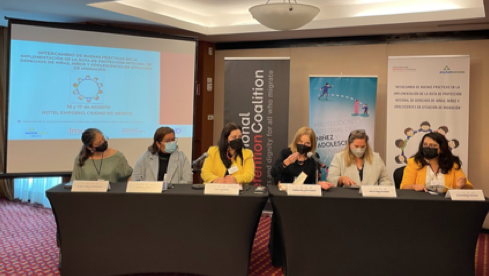
In seeking to create a space for protection authorities and state Protection Systems to meet, discuss actions undertaken for the protection of migrant children, and build agreements for collaborative work, the following results were achieved:
- Progress in articulating municipal-state-federal level authorities to coordinate the attention to and protection of migrant children, including establishing dialogue and coordination mechanisms.
- Recognition of the technical support and accompaniment provided by civil society organisations to municipalities and states in the implementation of the Migrant Child Protection Protocol on a state level.
- Broadening knowledge on promising practices implemented by participants. The Tenosique Protection Attorney shared practices regarding the attention given to migrant children, while the Comitan Child Villages explained their model of alternative care and demonstrated the effectiveness of an open-door space.
The event was positively evaluated by participants, and the need was highlighted to create similar spaces in order to share the work of counterparts in other states, as well as of federal and state institutions, in addition to how to articulate joint action.
The organising group will continue to strengthen capacity and provide technical support for the implementation of the Protocol together with alternatives to detention to the Protection Systems of the three states involved in the project. A second event of this kind is planned for 2023.
[1] The Commission for the Integrated Protection of Migrant Children and People Seeking Asylum, within the framework of the National System for the Integral Protection of Children, agreed on the Migrant Child Protection Protocol in 2019. The objective of the Protocol is to guarantee the rights of migrant children through articulation and collaboration between institutions responsible for their protection, and by identifying responsibilities and agreeing on forms of coordination.
Written by Elizabeth Alvares IDC Americas Programme Support
Coming Together for the Asia Pacific Regional Community-of-Practice Meeting
On the 9th and 10th of August 2022, IDC hosted an in-person, Asia Pacific Regional Community of Practice (COP) meeting in Kuala Lumpur. A total of 13 participants, representatives of CSOs working on ATD implementation and advocacy from Malaysia, Indonesia and Thailand joined the meeting - the first one in-person since the pandemic.
The meeting set out with several objectives:
- to provide an opportunity for peer learning and exchange of the key challenges and lessons learnt for implementing and advocating for ATD, particularly for children and vulnerable groups;
- to increase capacity and ability of participating members to strategise and advocate for ATD by engaging with governments, building stronger alliances across different sectors and working with refugee leaders and communities affected by immigration detention.
- to facilitate opportunities for further cross-country/bilateral collaborations between members
- to envision and lay the foundations for a sustainable, regional ATD platform among civil society members
In close conversation and collaboration with fellow refugee rights advocates, the COP participants launched into discussions on connecting national-regional-global advocacy, with the Malaysian and Indonesian participants both indicating interest in exploring engagement at an ASEAN level, with Malaysian participants also keen to kick start engagement with diplomatic missions, embassies, and the National Human Rights Commission. On the other hand, Thai participants were interested in elevating issues of women, children, and gender-diverse people who are affected by migration to improve their access to gender-responsive support services via the upcoming CEDAW shadow reporting.

There was also substantial interest and discussion around leadership and engagement of persons with lived experience of immigration detention, with the participants recognising the need to have systemic shifts to ensure that people with lived experience are shaping and leading the work and advocacy at multiple different levels. In this vein, we discussed current initiatives in Thailand and Malaysia, and opened the floor for an honest sharing session and discussion around the relationships between Civil Society Organisations (CSO) and lived experience leaders, in particular, encouraging being mindful of tokenising of refugee participation as compared to meaningful and mutually beneficial engagement.
The CSO participants also explored key topics they would like to explore further, at the upcoming Regional ATD Peer Learning Platform which will be joined by representatives from the governments of New Zealand and Australia, alongside the governments of Malaysia, Thailand, and Indonesia. Topics of interest included advocating for the rights and release of people with medical vulnerabilities, benefits of ATD for governments, mechanisms to facilitate access to education and healthcare, and inclusion of lived experience leaders in both CSO spaces as well as government spaces.

As the group moves forth, we mutually agreed to coordinate our advocacy efforts and explore regional collaborations through joint statements, cross-country campaigns, and advocacy using regional mechanisms. After all these years, coming together again in-person to share our experiences, strengthen networks, and collaboratively develop strategies was reinvigorating for both the participating CSO members as well as the IDC team members involved. Learning from each other - about our achievements, and challenges; and planning towards future regional cooperation is a reminder that systemic change can be made reality through sustained, coordinated, multilateral collaboration.

Written by Hannah Jambunathan IDC Community and Engagement Organiser - Malaysia
Director's Report: IDC's New Mapping Research
Written by Carolina Gottardo IDC Executive Director
In September 2022, IDC was proud to officially launch two pieces of research and their accompanying country profiles: Our global mapping report Gaining Ground: Promising Practices to Reduce and End Immigration Detention, and our Asia Pacific report Immigration Detention and Alternatives to Detention in the Asia Pacific Region, which was developed in collaboration with the Regional UN Network on Migration for Asia and the Pacific under the umbrella of the UN Network on Migration.
Our launch event in September featured a Cross-Regional Roundtable Dialogue that brought together representatives from communities, organisations, and governments across the world to discuss promising practices that illustrate the potential for migration governance without immigration detention. We heard from these experts at local, national, regional, and global levels about how to use this new research to scale up rights-based alternatives to detention (ATD) and further advocacy to reduce and ultimately end immigration detention, including by supporting improved implementation of the Global Compact for Migration (GCM).

For almost 15 years now, IDC has worked alongside its members across the globe to strategically build movements and influence law, policy and practices to end immigration detention and implement rights-based ATD. IDC prioritises research and building an evidence-base to support in this effort, and since our founding, we have published over 35 international, regional and national research reports and briefing papers related to immigration detention and ATD.
As set out in our flagship report, There Are Alternatives, ATD shifts the emphasis of migration management away from security and restrictions towards a pragmatic, proactive and solutions-based approach focused on case management, case resolution and human rights. As detailed in IDC’s 2022 position paper, Using ATD as a Systems Change Strategy Towards Ending Immigration Detention, IDC believes in alternative approaches that respect refugees, migrants, people seeking asylum and others on the move as people with rights and agency, who can be supported through immigration processes while living in the community, without being deprived of their liberty.
New Research
IDC’s new research shows that progress in moving away from the use of detention has been slow, and too often there continues to be a lack of awareness among governments, local authorities and other actors of alternative approaches. However, in recent years IDC has seen a number of states begin to recognise that effective and feasible alternatives to detention do exist. This has led to shifts that include the adoption of laws and policies enshrining non-detention or setting out ATD, the introduction and scaling of community-based pilot projects, establishing screening, assessment and referral mechanisms that help to reduce the use of detention, as well as the development of alternative care arrangements for children which - in the best cases - integrate migrant children directly into national child protection systems.
IDC’s new research aims to set out some promising practices, and provides an overview of practical examples and recent developments in the field of ATD, in order to encourage further progress in this area and to inspire and embolden governments, local authorities, international organisations, community actors, civil society and other stakeholders, with steps they can take to move away from the use of immigration detention which is ultimately what we want to see.
Given the ample scope of the two reports, it is very difficult to provide a fitting summary. However, I would like to highlight a few key findings:
- The use of immigration detention continues to be widespread in most regions of the world, probably with the exception of South America. A number of countries continue to detain people arbitrarily and, in some cases, without putting a time limit on the amount of time people can be detained. The Asia-Pacific mapping report, in particular, has highlighted the lack of regular and comprehensive screening for individual vulnerabilities, and limited recourse to challenge detention decisions before a court or independent administrative body. However, this is by no means unique to this region, and across the world we have found that the structures and processes necessary to ensure that people are not detained are missing or inadequate.
- The sheer diversity of people at risk of immigration detention across the world continues to be staggering. This includes migrant workers, refugees, people seeking asylum, stateless persons, undocumented migrants and survivors of trafficking, amongst others. It is critical to view the impacts of immigration detention through an intersectional lens, and to understand that people’s diverse and intersecting identities impact them in very specific ways. This includes migrant women, girls, transgender, gender diverse, and LGBTI+ communities, who are all likely to have very specific experiences of immigration detention that will coincide with the layered harms of also facing discrimination based on race, ethnicity, religion, disabilities and culture, among other factors.
- Despite the challenges and gaps that persist across most regions of the world, there have nonetheless been a number of encouraging developments. These include the introduction of laws, policies and practice that prohibit immigration detention in law, either across the board or of certain groups, or that introduce ATD in law, or result in people being released from detention. There have been efforts in some countries towards regularisation and the provision of legal status and documentation, and in others, efforts to implement better screening, referral and assessment mechanisms. There is also an increased willingness on the part of some governments to work towards a whole-of-government and a whole-of-society approach to migration, often utilising peer learning initiatives at the regional and global levels. There has also been important progress and momentum built towards ending the immigration detention of children, with several countries either not detaining children in practice or introducing legislation to restrict the detention of children and other efforts to strengthen child protection systems and alternative care arrangements.
The examples highlighted throughout the reports range from rights-based ATD initiatives and programmes to other developments in law, policy and practice that - while perhaps not always ATD per se - represent promising steps towards reducing and ending immigration detention. What all the examples have in common is that they contain some of the elements that IDC sees as necessary for states to move away from detention as a tool of migration governance.
While these reports only represent a snapshot of what is currently going on around the world, we at IDC hope that by showcasing such examples we will contribute to the sharing of ideas, experiences, challenges and progress in this critical area of migration policy and that governments and other actors are encouraged to take steps to implement ATD and end immigration detention.
Finally, when thinking about grounding and impact and building momentum towards reducing and ending immigration detention, we need to think first and foremost about the people affected by these policies who should be at the forefront of these efforts. This brings to my mind a quote from a person affected by immigration detention who said, “to end detention we will need the same perseverance and determination as those who have survived detention.” We must stand firmly in this struggle with perseverance and determination.
Working to Uphold People’s Rights in the Digital Age of Migration Policy
IDC’s New Workstream on Technologies, Detention & Alternatives to Detention (ATD)
Whether we like it or not, when it comes to migration governance digital technologies are here to stay. From customer service portals to collection of biometric data, forecasting models to face recognition tools, over the past two decades such technologies have been increasingly used by governments across the world in the conception and design of their migration systems. The COVID-19 pandemic further accelerated this trend.
Yet, these types of technology are never neutral. There is no such thing as a technical ‘fix’ to a complex problem, and efforts by some to portray digital technology as the solution to human bias have been shown to be at best naïve, at worst dangerous. When Artificial Intelligence (AI) and digital technologies are employed, this is a political choice. But the people deciding rarely experience these policies themselves. It is people on the move, as well as their families and communities, who ultimately find themselves at the ‘sharp edges’, subject to policies and practices that they have no control over and little to no agency in shaping.
Technology & (Alternatives to) Immigration Detention
Immigration detention and alternatives to immigration detention (ATD) have been acutely impacted by the expanded use of technologies in migration governance systems. For instance, certain digital technologies utilised within the carceral system (e.g. ‘Smart Prisons’) are now being adopted in the context of immigration detention. Meanwhile, technologies such as electronic monitoring and facial and voice recognition are being used or explored by a growing number of governments, ostensibly as part of their efforts to move away from the widespread use of immigration detention and put in place ATD. While this may seem like progress, these trends raise serious concerns for IDC.
Information surrounding the use of tech in ATD – and its impacts on people – remains largely confined to data from a few key countries (namely Canada, the UK and the USA). But we know that an increasing number of governments are contemplating the idea of employing such tech, if not already actively using it. In the European Union, for instance, Denmark, Hungary, Luxembourg and Portugal have all established the use of electronic tagging in law or administrative regulations. Turkey, meanwhile, has included electronic monitoring on a list of authorised ATD included within amendments to the Law on Foreigners and International Protection made in 2019 (but yet to be implemented).
IDC members working with communities and individuals affected by detention or at risk of detention, have been increasingly expressing concerns about the growing use of such technologies in the immigration detention space. People at risk of immigration detention are particularly vulnerable to the misuses of digital tech; they often have precarious immigration status and thus little ability to assert their own rights if technology is abused.
Over the coming months IDC plans to launch a workstream focused specifically on the use of technology and AI in immigration detention and ATD. In particular, we aim to examine:
Alternative Forms of Detention & De Facto Detention
On the whole, research to date has focused on how States have used digital technologies to further restrict people’s liberties, undermine their human rights, and increase surveillance and enforcement. This has been labelled “techno-carcerality” in the context of the Canadian government’s ATD programme, and represents “the shift from traditional modes of confinement to less traditional ones, grounded in mobile, electronic, and digital technologies.” A report on the Intensive Supervision Appearance Programme (ISAP) in the USA stated that its electronic monitoring components amount to “digital detention.”
Over the years, IDC has warned against the use of alternative forms of detention – which are de facto deprivation of liberty, simply detention by another name – and the potential for the term ATD to be co-opted and used as a smokescreen for such initiatives. Specifically regarding electronic tagging, IDC has been clear:
IDC classifies electronic tagging as an alternative form of detention rather than an alternative to detention, as it substantially curtails (and sometimes completely denies) liberty and freedom of movement, leading to de facto detention. It is often used in the context of criminal law and has been shown to have considerable negative impacts on people’s mental and physical health, leading to discrimination and stigmatisation.
More broadly, electronic monitoring devices pose a threat to personal liberty as a result of heightened surveillance and indiscriminate data collection. We know, too, that voice and facial recognition technologies have questionable accuracy, especially for communities that are racialised. This can lead to mistakes that have serious and irreversible consequences – including detention, deportation, and the separation of families and loved ones.
Tech as a Way to Improve Engagement?
Yet there are also some anecdotal reports that the use of digital technologies in ATD can have some benefits for people on the move. One notable example is the shift in the UK from in-person reporting to telephone reporting. This approach was originally tested during the pandemic, and then adopted on a more permanent basis in large part due to sustained advocacy from campaign groups. IDC has heard accounts from people subject to reporting requirements that this shift has helped ease in-person reporting requirements that were onerous, expensive and disruptive to their livelihoods and schooling. Moreover, places such as police stations and reporting centres often cause people increased anxiety that they will be redetained; limited physical contact with such places is likely to have a positive impact on people’s mental health and wellbeing.
Of course, as one of the groups campaigning for this change stated, “[t]elephone reporting itself could be equally burdensome if implemented without care.” It is essential that people are provided with the means to report in this way (for instance with support to buy a telephone and credit), and that the consequences for missing a call are not harsh; otherwise, this type of reporting can have negative impacts on people. Moreover, whilst the use of phones is a relatively rudimentary form of technology, it is important that tools such as voice or face recognition are avoided for the reasons mentioned above.
Lived Experience of Tech-Based ‘ATD’
IDC’s main impetus for launching this new workstream on technology, immigration detention and ATD has come from our members, and in particular the experiences and insights of leaders with lived experience and community organisers on the ground who we engage with on an ongoing basis. Through this workstream, in particular, we hope to explore the impact that this technology is having on people’s lives, wellbeing, and futures. Since our founding almost 15 years ago, IDC has been advocating for ATD as a way of moving towards migration governance systems that do not use detention and – crucially – ensure that people on the move have the agency and the ability to meaningfully engage with such systems.
Therefore, we hope to understand not only how tech can be harmful to people on the move, but also if and how it can help to increase positive and meaningful engagement. This will help IDC to better assess how to partner with others to push back on certain types of technologies, and also where innovations might open up opportunities for people with lived experience in terms of improvements to services, information provision, and communication. This will include looking at the impact of digital technologies through an intersectional lens, and understanding that people’s diverse and intersecting identities mean that their experiences of such technologies vary greatly.
Accountability & Due Process
Last but not least, the question of accountability – and the distinct but related issue of due process – is one that we are hoping to explore through this programme of work. Use of AI and tech in the migration governance sphere is notorious for lacking transparency, which is potentially very harmful, particularly when methods are being implemented towards people who struggle to access their fundamental rights and legal recourse. Additionally, ATD themselves can lack key safeguards that allow for due process. The right to appeal and review a decision to detain is often expected in detention (whether or not it is respected in practice), however the same is not necessarily true when somebody is placed in an ATD programme. Where restrictions are imposed, including those linked to digital technology, these should be subject to rigorous review, and the right to appeal should be standard.
When technology is used to increase people’s freedom of movement and ability to access information, as well as to increase their agency and support their empowerment, it has the potential to uphold key human rights and standards. However, when the primary purpose of digital technologies is to expand surveillance and enforcement-based monitoring, it has the opposite effect and leads to the curtailment of rights and freedoms. Unfortunately, given the increasing tendency of many states across the world to adopt migration governance systems based on criminalisation, coercion, control, and deterrence, their growing use of technologies risks exacerbating what are already restrictive, harmful and unaccountable systems.
IDC will learn and build upon some of the excellent research that already exists, and we will compile resources and develop insights for our members and partners. Our ambition is that, by getting to grips with this issue, we can support the growing movement to ensure that use of technology in the immigration detention and ATD space does not lead to a further erosion of human rights and dignity for migrant, refugee, and asylum seeking communities.
Written by Hannah Cooper IDC Europe Regional Coordinator and Carolina Gottardo IDC Executive Director. IDC would encourage anyone interested in collaborating on this workstream to get in touch with us; we look forward to connecting with others on this crucial issue.
Beyond the 2022 IMRF: What’s Next?
The May 2022 International Migration Review Forum (IMRF) was a critical moment to connect local, national, regional and global advocacy efforts, and represented a key milestone towards building momentum on ending child immigration detention and prioritising alternatives to immigration detention (ATD). It also presented an opportunity for the migration sector to shape the global narrative of civil society advocacy, and to set a foundation to focus on the rights of migrants and national level change for the next four year cycle ahead of the next IMRF in 2026, as discussed in IDC’s Approach During the IMRF and Beyond.
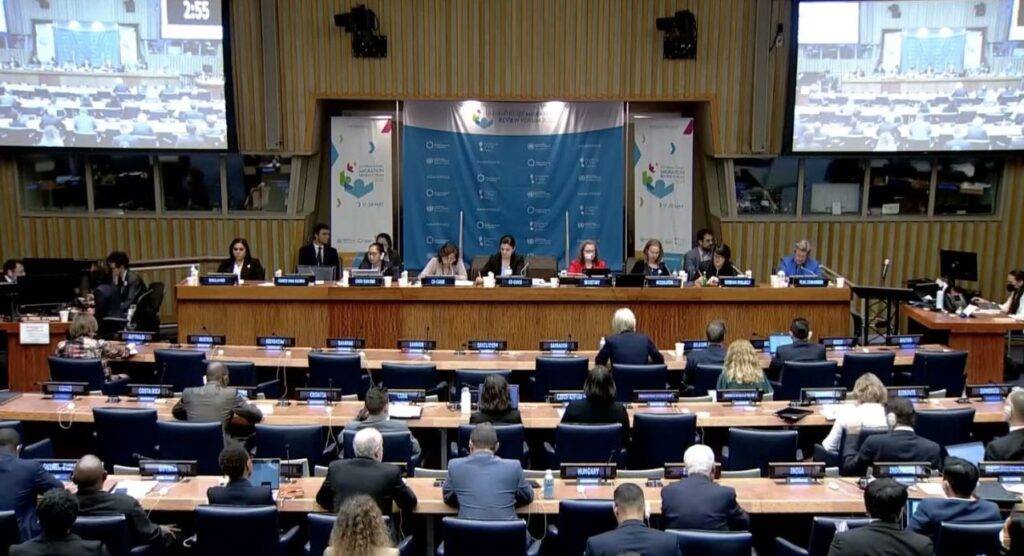
Since the adoption of the Global Compact for Safe, Orderly and Regular Migration (GCM) in December 2018, there has been an incredible amount of work accomplished to build on the adoption of the GCM under a whole-of-society approach, including by civil society groups and organisations, governments, local authorities, UN agencies and other stakeholders. For example, the UN Network on Migration was established in 2018 “to ensure effective, timely and coordinated system-wide support to Member States” in their efforts to implement the GCM. Building a functioning system of support at national, regional and global levels has been a key priority for the UN Network on Migration over the past four years.
Within the UN Network on Migration, IDC is proud to co-lead, with UNHCR and UNICEF, the Working Group on ATD which is tasked with promoting the development and implementation of non-custodial, human rights-based ATD in the migration context, in line with Objective 13 of the GCM. Working Group members include representatives of civil society organisations, migrant communities, young people, local governments, and UN agencies working on immigration detention issues and ATD across the world. The Working Group has developed a set of technical guidance and snapshots on ATD, and has steered, in collaboration with the governments of Thailand, Portugal, Colombia, and Nigeria, three global peer learning exchanges on ATD in recent years. IDC also co-leads the UN Migration Network Group working group on ATD in the Asia Pacific, as well as co-leads working groups at the national level to implement Objective 13 of the GCM. These efforts, such as linking national, regional and global initiatives, are part of a long-term movement to reduce and ultimately end immigration detention, and resulted in detention and ATD being key priorities for States to address during the IMRF (also view the IMRF press conference by the President of the General Assembly to hear more about the priorities, including ATD).
What actually happened at the IMRF?
During the IMRF, some States, including Colombia, Mexico, Germany, Thailand, among others, made pledges regarding ending child immigration detention and promoting best practice on this matter. IDC supported in drafting some of these global pledges, which was a process that exemplified the importance of sustained advocacy, collaboration and strategic government engagement at global, national and local levels, as well as the GCM principles of whole-of-government and whole-of-society approaches. The UN Network on Migration has launched The Pledging Dashboard to collate State commitments in the implementation of the GCM. Please review and see if your government has made a pledge!
With regards to immigration detention and ATD, both issues were featured quite extensively in State and multi-stakeholder discussions throughout the IMRF. This included commentary on concerns about the increasing and aggressive use of immigration detention in many regions of the world, as well as analysis of progress being made to promote ATD more widely and to work to end child immigration detention. In particular, child immigration detention was a centrepiece of detention-related discussion, and proved to be quite contested in the negotiations and eventual adoption of the 2022 IMRF Progress Declaration. While the GCM itself includes actionable commitments to work to end child immigration detention, some States attempted to now soften this commitment through the negotiations of the Progress Declaration. However, through the multi-level, multi-stakeholder advocacy of IDC and its partners at the IMRF, and the effort of some champion countries, the issue was indeed advanced in the Progress Declaration and included States determination to “consider, through appropriate mechanisms, progress and challenges in working to end the practice of child detention in the context of international migration.”
Key IMRF Takeaways
For IDC, the framework for moving forward beyond the 2022 IMRF will involve coordinating a multi-level agenda that uses national, regional and global momentum to make change on the ground and that centres the rights of migrants in all GCM implementation efforts. Particularly key for IDC in the next period, in our role as a convener of multi-level peer learning, is ensuring connection, coherence and coordination between national, regional and global efforts, which will allow us to enhance whole-of-government and whole-of-society approaches in the interest of change. The key takeaways from the 2022 IMRF that will support and guide our work across all levels include:
1. Global Visibility of Immigration Detention & ATD
Following much political turmoil in various global and regional processes over the years - addressing the use of immigration detention, working to end child immigration detention and the promotion of ATD are now solid components of the global migration agenda through the GCM. This is an important win, and resulted from the sustained strategic engagement and narrative shifting performed by many actors across various spaces. The next step is to use this global affirmation to enhance and leverage national action and change that results in tangible protection of migrant rights towards a world without immigration detention.
2. Multi-Level Peer Learning as a Key Approach
Through the UN Network on Migration Working Group on ATD and regional Platforms such as a the Regional State Platform in the Asia Pacific , IDC and its partners have coordinated and led peer learning processes for government actors over many years. IDC advanced this particular methodology across local, national, regional, and global levels through the development of communities of practice. This method has now been integrated into the Progress Declaration and officially recognised as a mechanism for analysing progress, “...calls on the Network to cooperate with Member States and relevant stakeholders to strengthen collaboration, peer-learning, engagement and linkages at global, regional, national and local levels.”
3. Centering Grassroots & Lived Experience Leadership
While purposeful efforts have been made to address the limited adequate mechanisms for engaging civil society in UN and global processes, particularly directly impacted people and communities - this is a systemic issue that requires a systemic solution. An entire mindset shift regarding leadership, equity, and accountability is needed to transform these systems and ensure meaningful participation and representation moving forward. As discussed in IDC’s article in the Spotlight Report on Global Migration, “Migrants give life to these issues, and are key to making this necessary transformation in collaboration with different stakeholders, including government allies. To end immigration detention we will need the same perseverance and determination as those who have survived detention. And if we work together with solidarity, understanding, and with a genuine desire to make a change, we can achieve it (page 19).”
Moving Forward
IDC alongside our members and partners in the coming period, will focus on ensuring implementation of the pledges made at the IMRF, expanding advocacy on ending immigration detention beyond ending the detention of children, continuing to connect local, national, regional and global agendas, facilitating and coordinating strategic peer learning spaces, and centering the leadership of people with lived experience of detention in all of our efforts.
The focus of the UN Network on Migration moving forward will be national implementation, including the development of national action plans by governments. As such, all of our roles in actualising the GCM are most important now that we are beyond the 2022 IMRF. As civil society, we must be ready to organise, engage, and advocate to ensure governments are living up to their GCM commitments on the ground. There will be an Annual Meeting of the UN Network on Migration in October 2022, where these priorities will be discussed and a new work plan for the Network will be developed with the input of civil society and other actors. Additionally, IDC aims to enhance the Working Group on ATD exchange space by redesigning it to more effectively connect national, regional and global levels in order to increase our collective ability to give life to the GCM. This will involve creating a more diverse and dynamic membership for the Working Group in the upcoming period. Additionally, we will continue with our work as co-leads of the ATD Working Group in the Asia Pacific and with the Regional Networks in other regions; and also continue co-leading relevant working groups and participating in UN Migration Network national efforts in selected GCM champion countries. Key to this agenda will be the effective coordination and connection between national, regional and global initiatives aiming to implement Objective 13 and promote ATD to ultimately end immigration detention. Please contact IDC Global Advocacy Coordinator Silvia Gómez [email protected] for more information and to explore possibilities for engagement.
Lastly, four months after the IMRF, IDC will host an event on 21st September 2022, to launch our global mapping report Gaining Ground: Promising Practices to Reduce and End Immigration Detention and our Asia Pacific report Immigration Detention and Alternatives to Detention in the Asia Pacific Region, which was developed in collaboration with the Regional UN Network on Migration for Asia and the Pacific under the umbrella of the UN Network on Migration.
REGISTER and join us to hear from experts at local, national, regional, and global levels about how to use this new research to scale up rights-based ATD and further advocacy to reduce and ultimately end immigration detention, including by supporting improved implementation of the Global Compact for Migration (GCM).
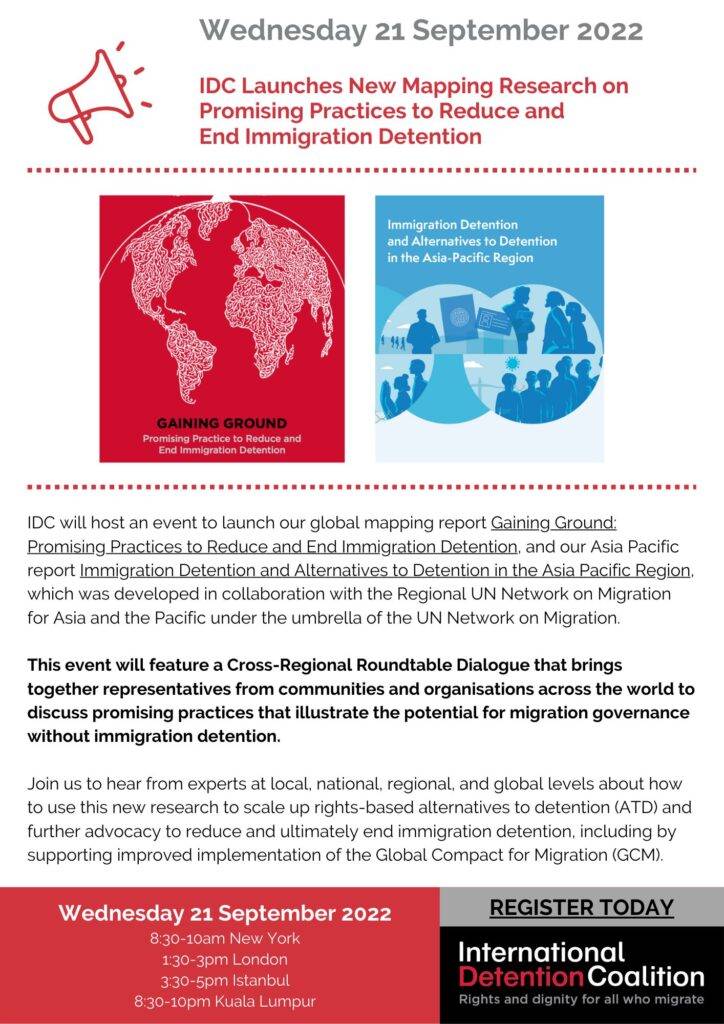
Written by Carolina Gottardo Executive Director, Silvia Gómez Global Advocacy Coordinator & Mia-lia Boua Kiernan Communications & Engagement Coordinator
Monitoring the Situation of Migrant Children in Chiapas, Tabasco & Veracruz, Mexico
IDC's Americas Regional Programme is currently undertaking research into the situation of migrant children on the southern Mexican border. One of the objectives of this study is to explore whether children are indeed no longer detained due to their migration status, following the 2020 legal reform which prohibited their detention in immigration detention centres.
The initial findings of the study were recently presented in Mexico City, focusing on the following two research queries:
Confirm whether local authorities are familiar with the Migrant Child Protection Protocol (CPR), created in 2019 by a federal commission.
Verify the implementation of the Migration Law reforms, which prohibit the detention of accompanied and unaccompanied children in detention centres.
The first step in the research was to request public information and official responses with data and input from authorities who participate in the CPR and who attend to this population.
This was followed by on-site visits to three southern Mexican states to conduct interviews with authorities regarding their work procedures, as well as their strengths and weaknesses. In particular, we aimed to cross-check official data with reality.
Findings
The visits corroborated that state and municipal authorities have limited knowledge of the CPR, although it is worth mentioning that all do have reception and care procedures. Nevertheless, these are far from what is stipulated in the CPR, particularly regarding issues around inter-institutional communication and coordination, and hence the importance of implementing state protocols.
There is also an urgent need to strengthen the State and Municipal Protection Attorneys, who have limited human and material resources with which to fulfil their obligations as established by law. This is evidenced by the fact that international agencies, such as UNICEF and UNHCR, are currently paying the salaries of members of the multidisciplinary teams who carry out best interests evaluations and determinations.
In addition, there is insufficient capacity in the Centres for Social Assistance (shelters) to receive children referred by the National Institute of Migration, which impedes full compliance with the reform. Although certain funding was made available towards the end of 2021, beginning of 2022, this has been insufficient and has only enabled the reception of children in order to immediately return them to their countries of origin, lacking a human rights protection perspective.
One of the main and surprising findings of the study relates to where children are held, given that there is insufficient capacity to receive them. They were found to be held in so-called “referral offices,” created by the Instituto Nacional de Migración (INM). Children remain there until their migration procedure has been resolved, or until referred to the protection authorities. In many cases, this is done without an assessment of their situation and therefore without a determination of their best interest. In flagrant violation of the Migration law reform, at least in the states in which the research is being conducted, these offices are located next to detention centres and also depend on the INM. This contravenes the reform that prohibits the enabling of spaces for the detention of children in order to avoid the claim that children are not being held in detention centres.
Finally, it is worth mentioning that interviews with the Guatemalan and Honduran consulates in the region revealed that while they recognise the importance of the reform, they are concerned by the lack of institutional capacity to provide reception and care for the total number of children.
All authorities appear to be aware of the practices and significant shortcomings in service provision, and expect support and advice. It is notable that the work of those authorities that have collaborated with and received support from civil society organisations including IDC has advanced considerably in comparison with those who are more resistant and have not been open to such collaboration.
These findings underpin a second phase of advocacy in the three states, aimed at ensuring better practices.
By Pablo Loredo IDC Americas Monitoring & Evaluation Officer

